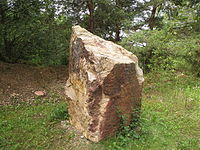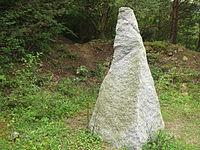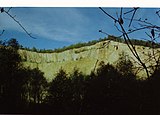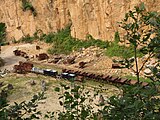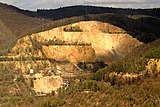Dossenheim quarries
The quarries of Dossenheim are located on the western slope of the Odenwald to the Upper Rhine Plain east of the village of Dossenheim . There are four main and several side quarries, in which mining mostly began in the 19th century and was mostly discontinued in the 20th; the last work ended in 2002. The quarries were last operated by two large companies. In its history, the quarries had a strong impact on the Dossenheim community. In one of them, some of the old systems are now open to the public.
location
The quarries are almost two kilometers long above the western slope of the Odenwald, which is broken up here by the streams of Mantelbach, Brenkenbach and Dossenheimer Mühlbach, at a height of between 170 and 290 m above sea level. NN . The first row of the visible peaks of the low mountain range in the east reaches in the Hoher Nistler with 496 m above sea level. NN their greatest height. The village of Dossenheim lies in front of her in the west, between 110 and 180 m above sea level. NN , whose settlement area is in many places only a few steps away from the quarries. Because of their considerable size and their high yellow mining edges, which can be seen from afar, the quarries shape the appearance of the southern mountain road , with the Schriesheim quarry adjoining it in the north . From north to south follow one another:
- Broken castle, on the southern spur of the Mount of Olives under the remains of the Schauenburg ruins , north of the Mantelbach cut, dismantled in 1891 - approx. 1929. Location
- Break at Sporenberg ( "Vatter break" / "major break"), at the foothills Sporenberg between coat Bach - and Brenke Bach -Taleinschnitt, dismantling 1834-2002. location
- Bruch am Kirchberg, at the spur tip of the Kirchberg between Brenkenbach and Mühlbach valleys, mining from around 1760 until the 1950s. location
- Break at the Hohen Nistler ("Leferenzbruch"), on the western foothills of the Hohen Nistler south of the Mühlbach cut, dismantled 1883–1985. location
There are also a few minor side breaks.
Between Dossenheim and the Heidelberg district of Handschuhsheim in the south there is another small quarry in the Höllenbachtal . location
Occurrence
Rhyolite (older name: quartz porphyry), a porphyry rock , was mined in all of Dossenheim's quarries . This originated there in the Permian about 290 million years ago, when there was still brisk volcanism in the region . The porphyry layer is partly over 150 meters thick.
The Dossenheimer rhyolite is partly rich in large quartz crystals and partly poor in sprinkles. Porphyry is used as ballast in road and railroad construction. The cooling of the rock after the eruptions and the associated reduction in volume resulted in many cracks and fissures in the rock that can still be seen today.
Granite is also often formed during the genesis of porphyry, but this has sunk deep in the Dossenheim area and has never played a role in the local quarry industry.
history
Beginnings

The history of porphyry mining in Dossenheim goes back to the second half of the 18th century, so the mining was first mentioned in 1760. In those early days, rocks were mostly quarried for extra income on a private basis. The preferred place for this was the western slope of the Kirchberg, which is easily accessible from the village.
The porphyry was mainly used in road construction and also there with the construction of railways . Due to its chemical composition, the Dossenheim porphyry is very resistant and therefore well suited for substructure and ballast production. Stone quarrying therefore increased slowly and steadily, so that in 1813 the community tried for the first time to generate income from it by introducing a road toll . From 1834 onwards, additional land was opened up in the municipal administration and leased for rock mining. In the years that followed, stone carving saw a rapid rise. In 1840 the trade was mentioned for the first time in a municipal bill, whereby the transport of the broken material played an important role. So some farmers became pure hauliers who mainly brought the rock to the Neckar .
The quarry industry multiplied the population of Dossenheim, from around 800 in 1800 to around 3000 in 1900. Even migrant workers from Austria , Italy and Switzerland were drawn to the town at the turn of the century.
The self-administration of the entire company by the municipality, however, did not prove to be successful. The quarries were technically outdated compared to those in other places, innovations were made difficult for a long time. Little was paid to the workers either. In many cases, pub excesses and other uninhibited alcohol consumption were reprimanded. Child labor up to the age of 13 was no longer allowed since 1891, but the municipality only prohibited it after threatening the district office several times . Since there were many tenants, they competed with each other, which was ineffective. The same was true of the carters. However, these merged after a while, which initially gave them a monopoly .
Changes by reference
In addition to the poor self-government, the community also suffered a problem from private competition at the end of the 19th century: In 1882 the entrepreneurs, the Leferenz brothers and their civil engineering and railway construction company, bought a large area on the western slope of the Hohe Nistler and an area on the Mountain road with a connecting strip in between. The aim of the entrepreneurs was actually to build a secondary line from Heidelberg to Schriesheim and to expand it later. In 1883 they finally received the concession , even with the option to run the route to Weinheim . Because of their poor financial situation, the brothers made a proposal to the community: their company should build a connecting line between the community quarry and the railway at its own expense, which would become the property of the community after 20 years. In return, the community should undertake in future to only transport the broken material to Heidelberg via the Leferenz brothers' railway line . If the proposal is accepted, Leferenz would undertake not to operate a quarry itself. Since the stone carters saw their work threatened, the citizens 'committee meeting, under their pressure, narrowly decided against the brothers' proposal. The company then used all of its resources to build the quarry; a loading station was built on Bergstrasse and a cable car was put into operation at the break . The branch line could no longer be realized afterwards.
This second large operation, which was significantly more modern and efficient than the parish cave-in, made the community stiff competition, which is why they had to take on huge debts to modernize their own plant. The opening of the Schriesheim porphyry quarry Edelstein on the Mount of Olives in 1900 caused further problems for the community. With the two factories now, the place was even more strongly characterized by quarrying; At that time Dossenheim was often called "Steinbrecherdorf". At the time of the First World War , over 400 people were employed in the quarry industry, around 15 percent of the population at that time.
As a result of the modernization work of the community, new territory was opened up: In 1891 the castle break was opened, to which part of the Schauenburg ruins fell victim. In 1897 the community decided to carry out a fundamental modernization in order to ensure the continued existence of the company. A cable car was built from the main quarry and the castle quarry , both of which led to a newly built plant on Bergstrasse. More modern machines operated by a steam engine were used in the loading station and in the quarries . From 1904 this even supplied the town with electricity. 1899 Verladewerk was now but a railway siding for running there Railway . The Leferenz factory had this connection since the railway opened in 1890; The Leferenz brothers had sold their concession to the entrepreneur Hermann Bachstein in 1887 , who finally had the narrow-gauge railway built.
In 1906 there was a further improvement in transport, with the establishment of a direct freight railway from Schriesheim via Dossenheim to the Heidelberg freight yard by the Süddeutsche Eisenbahngesellschaft (SEG) .
The privatization of the municipal enterprise
Despite these many measures, the municipal works continued to do poorly; in 1905 the debt burden was around 330,000 Reichsmarks . For this reason, too, the municipal burglaries were transferred to the state administration on January 1, 1908, after the municipality had been urged to do so several times, and conditions improved. The Karlsruhe Waterways and Roads Administration was now responsible .
The quarries experienced another boom in the following time. In 1913, Dossenheim was the largest porphyry plant in Baden with an annual production of 184,000 cubic meters , employing around 280 workers. But when the lease expired, Karlsruhe was no longer interested in continuing operations, also because there was a dispute with the community. The entrepreneur Hans Vatter from Mannheim was found as the new tenant . The economically bad situation and a big fire in the main quarry in 1929 were bad conditions for the operation, but the plants could also be renewed at this time.
From this time on, the number of workers was also reduced in the course of modernization, for example at the Vatter plant from 180 in 1928 to 105 five years later. However, production could be expanded slightly during this time, from 142,000 tons in 1930 to around 172,000 in 1950 (Vatter plant). From the Second World War , the transport changed, the motorization of traffic meant that the transport of goods shifted back to the road. In 1966, only around 5% of goods were transported by rail. In 1971, regular freight traffic on the Upper Rhine Railway was stopped by the OEG, so that the goods were only transported away by truck. This prompted the community to ask the Leferenz plant to relocate the loading station and the facilities there from the B 3 to the quarry; there were additional development plans for this area. The reference company implemented this: The cable car was dismantled - in its place is now partially Friedrich-Ebert-Straße - and the systems with loading works, main crusher etc. were placed in the quarry entrance. The Vatter loading plant remained on the B 3.
Closure of the quarries and subsequent use
The quarries found themselves increasingly faced with financial problems in the 1960s , as the sales prices for porphyry did not rise in line with spending. Overall, the quarry industry on the Bergstrasse lost its importance: Due to the rationalization , far fewer people worked in the quarries, new branches of the economy gained in importance. These increasing financial problems finally caused the Leferenz plant to close in 1985. The Vatter company was able to continue dismantling for the time being.
In the 1990s, however , there was increasing protest within parts of the population of Dossenheim against the rapidly advancing porphyry mining. The Vatter quarry finally closed its plant in 2002.
The large disused quarry areas raised the question of subsequent use. So the community decided to make the Leferenz quarry accessible to the public, to partially release it for associations and to recultivate it in certain places; for this it was partly backfilled. In May 2009 the quarry was finally opened to the public. A large part of the quarry is therefore accessible all year round, the core area with most of the machines, old systems and a light railroad is only open on certain days of the year, usually once every one to two months in summer. The quarry is now the junction of many hiking routes and part of the Neckartal-Odenwald nature park .
Various works are currently being carried out (2014) on the site of the Vatter quarry; it is not accessible.
nature
In all quarries, nature is slowly reclaiming the area. This is most advanced in those porphyry quarries that have been idle the longest. Quarry areas are generally interesting for many animal species, also because stagnant waters can form here , which disappear elsewhere, for example in floodplains or ponds .
The Leferenz quarry is of particular zoological interest. In this break, areas were purposely recultivated and backfilled. As a result, the quarry has become home to many endangered species, of which the yellow-bellied toad, which is on the red list , is particularly noteworthy. In the quarry you can also find many species of birds that can use the rugged rock walls as breeding grounds.
Picture gallery
The quarry at Sporenberg, view from the A5
In such shelters the workers protected themselves during explosions
See also
literature
- Rudolf Conzelmann: Dossenheim. The story of a 1200 year old mountain road community. Municipal administration, Dossenheim 1966, OCLC 311569268 .
- Heimatverein Dossenheim (ed.): Dossenheim. A traditional mountain road community in the course of its history , Dossenheim 2005.
- Jens Seeling: Heidelberg - Walks through the history of the earth , JSV Jens Seeling Verlag, 2005, ISBN 9783938973004 .
Web links
- Entry at the Ministry for the Environment, Climate Protection and the Energy Sector, Baden-Württemberg (Leferenz quarry)
- Entry at the Ministry for the Environment, Climate Protection and the Energy Sector, Baden-Württemberg (Sporenberg)
- Entry in "Industriekultur Rhein-Neckar"
Individual evidence
- ↑ Seeling 2005, p. 122 and own observation.
- ↑ a b Seeling 2005, p. 115f.
- ↑ a b Conzelmann 1966, p. 159.
- ↑ Seeling 2005, p. 116.
- ↑ Heimatverein Dossenheim 2005, p. 175.
- ↑ Conzelmann 1966, p. 159/160.
- ↑ Conzelmann 1966, p. 160.
- ↑ Conzelmann 1966, p. 161.
- ↑ a b Conzelmann 1966, p. 165.
- ↑ Conzelmann 1966, p. 162.
- ↑ a b c d e Conzelmann 1966, p. 164.
- ↑ Conzelmann 1966, p. 166.
- ^ A b Frank Muth: Tramways in Heidelberg, GeraMond Verlag , Heidelberg 2002, p. 157.
- ↑ a b Conzelmann 1966, p. 167.
- ↑ a b Conzelmann 1966, p. 168.
- ↑ Heimatverein Dossenheim 2005, p. 63/64.
- ↑ Conzelmann 1966, p. 169.
- ↑ Heimatverein Dossenheim 2005, p. 178.
- ↑ Heimatverein Dossenheim 2005. P. 71.
- ^ Entry at the Ministry for the Environment, Climate Protection and the Energy Sector, Baden-Württemberg
- ↑ Municipality of Dossenheim / Leferenz quarry (current opening times given)
- ↑ a b c Information board of the Neckartal-Odenwald Nature Park in the quarry.

